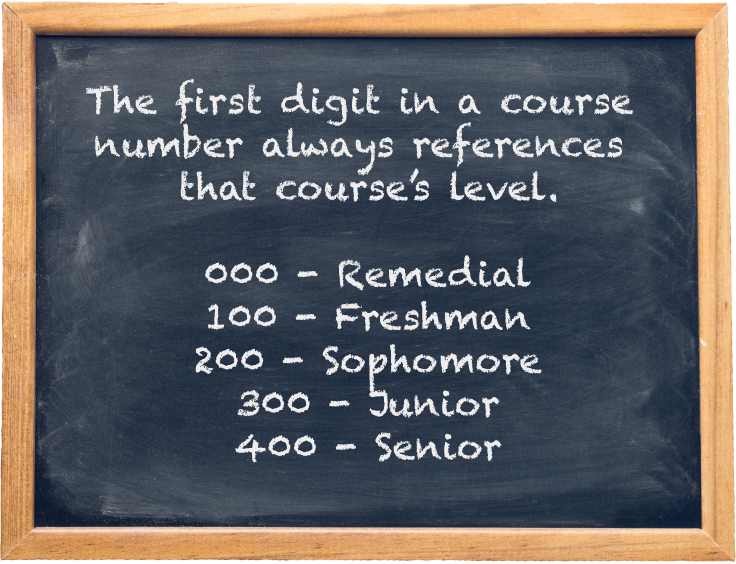Course Codes 101: A Beginner's Guide to Course Codes and Transfer Credit

I’m sure you’ve already heard the oft-repeated advice, “community college is cheaper than university.” And while it isn't flashy, you have to admit earning two years of inexpensive credit before transferring into a university is the best choice for your wallet.
But a couple of Google searches in, you’re accosted by horror stories of community college graduates losing nearly all their credit upon transfer.
Is taking a risk with transfer credit really going to be worth it in the long run?
Actually, yes. If you know what you’re doing, earning transfer credit can be a safe way to save money on your degree.
The key is to start with the end in mind and develop a foolproof plan before enrolling in any courses.
To do this, you must know which degree you want, which college you want to transfer to, and what their transfer policy is. Then you can spend your precious time and money on just the courses you know will transfer. (Here’s a step-by-step guide to get you started.)
But how do you know which courses will transfer before taking them?
The answer: college course codes.
Are you looking to earn college credit that is guaranteed to transfer? Or, do you have existing credit you'd like to transfer into a future degree? At Accelerated Pathways, our academic advisors can help! Get a complimentary advising session and find out about earning college credit that is guaranteed to transfer through our programs.
How College Course Codes Work
Colleges use course codes to describe and organize their courses in a way that can be easily understood by both colleges and students (if said students have translation guides, that is).
They consist of four important blocks of information.
1. Course Prefix
The first part of a college course code is simple: a series of letters indicating the course's general subject. This is the course prefix, and it’s fairly intuitive.
Tip: if you get stuck wondering what a particular set of letters means, compare several courses sharing the same prefix. Or Google it.
How to use it
Course prefixes will help you understand if the two courses you're trying to compare are part of the same academic department.
For instance, if your bachelor's degree requires 3 business math (BUS) or finance (FIN) credits, a general MAT math course won’t fit that requirement.
2. Course Numbers
The second part of a college course code is a series of numbers. These are often three digits long, but many colleges use four digits (or even five).
These numbers are the main way colleges organize their course catalog. No two courses at a college will share the exact same course number.
The most useful thing for students to understand about these numbers is how to distinguish between upper-level credit and lower-level credit.
Remedial courses do not count for college credit. Students only take them if they aren't able to start 100-level work yet. 100-200 courses are “lower-division” courses—often covering a wide range of foundational topics. 300-400 courses are “upper-division” courses. These courses provide more in-depth study, frequently in the student’s major.
(If your college uses a four- or five-digit numbering scheme, this rule will still hold true. 0000 is remedial, 1000-2000 is lower division, and 3000-4000 is upper division.)
The second and third digits in a course number are used in a variety of ways by different schools. While there isn’t a universal rule for what each number means in relation to each other, the main idea is just to distinguish different courses that are from the same department at the same level.
How to use it
Apart from that first digit, course numbers honestly aren’t very helpful for transferring credit. They vary widely between colleges and would take immense study just to learn how one specific college uses them. Even once you do understand your college’s system, these numbers won’t provide much assistance in understanding if your courses will transfer.
The one thing to remember about course numbers is that the first digit indicates what level of study your course is. That is likely the only uniform (and truly helpful) piece of information these numbers will provide for you.
3. Course Name
The third element of a course code is obvious: the name of the course. A course's name tells you what that course is about, and is actually the most useful way to compare courses.
Unlike course numbers, which are specific to each college, course names can be fairly standard between institutions—especially among lower-division subjects. (It’s likely the material taught in British Literature I at the University of Texas will match NYU’s British Literature I class.)
How to use it
Compare the name of the course you want to take to the name of a course your chosen college offers. The more exactly the names match, the better chance your credit will transfer.
Don't forget to check your degree’s program requirements, too. Does your college of choice require this specific course for your degree?
4. Course Description
The last thing you'll read about a course is its description. A course description is a general explanation of its topics and teaching methodology. This will give you added information about the course and the way it’s taught.
How to use it
When evaluating a transfer course from another school, colleges typically want to see at least 80% content overlap when compared to their own course. So even if a course you are considering has the same title as a course at your target school, be sure to examine the descriptions of each for similar terms and topics to get a feel for how well-aligned the content really is.
Where to Go From Here
So you’ve picked a college and degree. You also know more about college course codes than you ever wanted to. How do you start actually taking affordable transfer credit?
We can help.
For the past 15 years, our Central Registrar’s Office has helped thousands of students graduate debt free via affordable online courses selected specifically for their degree at their school.
We’ve already done the research you need, and can take the stress and confusion out of your college transfer.
Click here to learn more about degree planning through Accelerated Pathways, and how it can save you thousands of dollars on your bachelor’s degree.
However, if you think you're ready to go it alone, here are some other resources that may help you along the way:


